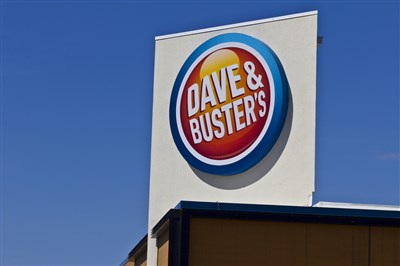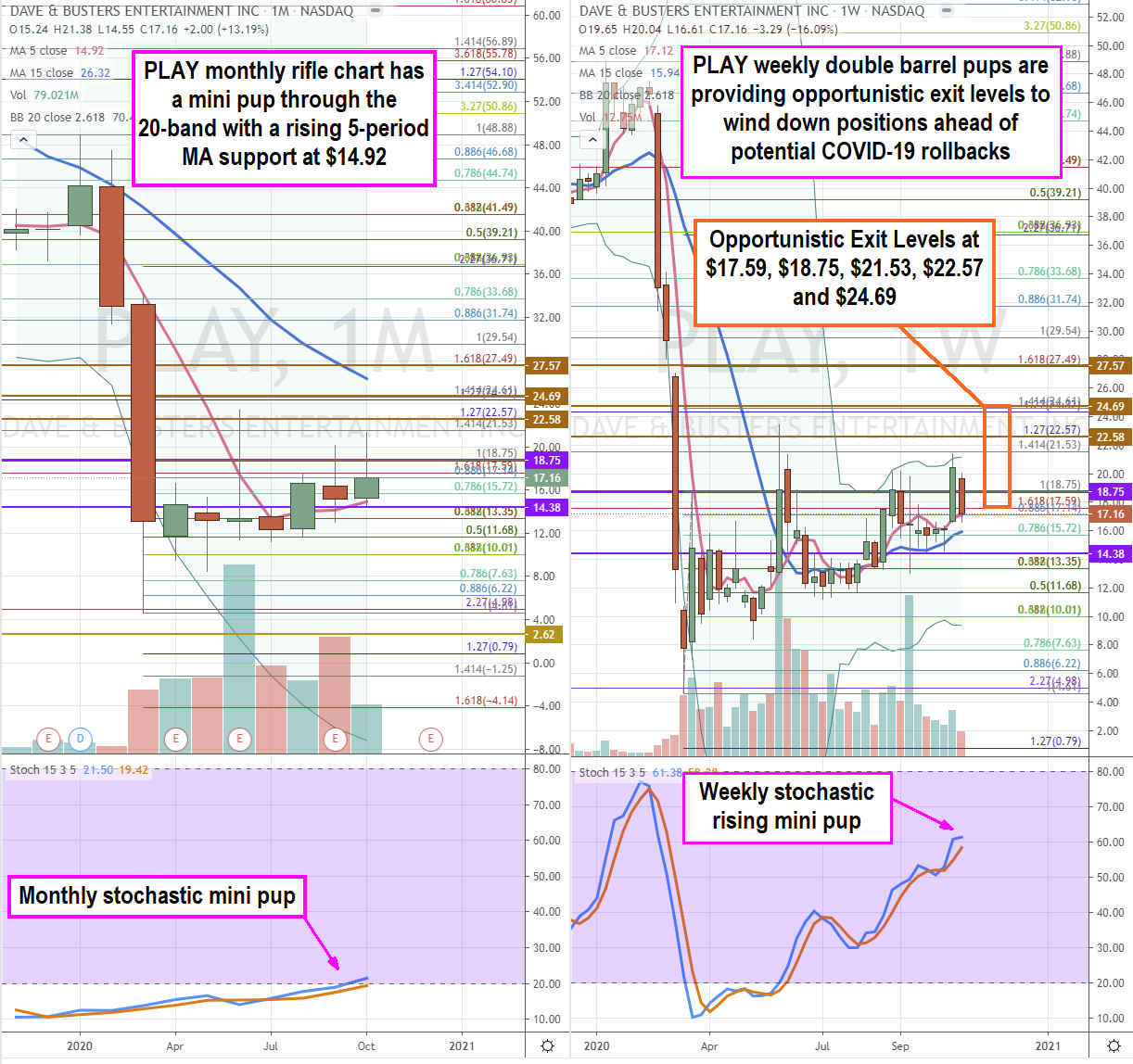
While entertainment and dining venue operator
Dave & Buster's Entertainment, Inc. (NASDAQ: PLAY) stock is still trading under half of its pre-pandemic highs, investors may want to consider winding down positions. Shares have rallied since our June 10
th MarketBeat Original article outlining pullback levels on earnings sell-the-news reaction. Movie theaters shutdowns and potential restaurant closures as winter weather limits already constricted capacity restrictions are growing headwinds that can impact Dave & Buster’s locations. Businesses are already deciding that its more cost-effective to close down rather than bear the additional costs of outdoor dining expenses. The cash burn is expected to increase as deferred rent paydowns get implemented starting in January 2021. Despite many of the concerns playing out as a global resurgence of
COVID-19 cases have warranted restart rollbacks, shares are still showing enough buoyancy for investors to take some profits into opportunistic exit price levels.
Q2 FY 2020 Earnings Release
On Aug 12, 2020, Brinker released its second-quarter fiscal 2020 results for the quarter ending July 2020. TheCompany reported an earnings-per-share (EPS) loss of (-$1.24) excluding non-recurring items versus consensus analyst estimates for a loss of (-$1.38), beating estimates by $0.14. Revenues fell (-85.3%) year-over-year (YoY) to $50.80 million and missing the $78.54 million consensus analyst estimates. Just to put things in context, the prior year ago second-quarter 2019 revenues were $344.5 million. Comparable store sales decreased (-87%) YoY using 68 stores versus 99 comparable stores in 2019. As of Sept. 5, 2020, the Company has reopened 89 locations operating under reduced capacity and hours as per local compliance mandates. The Company ended the quarter with $224 million in cash at the end of the quarter, which included the $111 million in proceeds from the May 2020 offering. Capex spending is expected to be $60 million as the Company plans to resume construction on 5 stores expected to finish and open by year-end 2020.
Conference Call Takeaways
Dave & Buster’s CEO, Brian Jenkins, provided quarter-to-date highlights. While the Company faced COVID-19 resurgence headwinds in July, the acceleration of improvements continued. Of the 84 reopened stores, 61 locations generated positive store-level EBITDA for the month of August. Management expects 11 New York and 16 California stores to be the last to reopen making up for 25% of system-wide sales. At the time of the conference call, the most recent 2-weeks indicate a “further improvement to 58%” or prior year sales. The cash burn rate improved to (-$3.3 million) per week on average for Q2. Jenkins stated, “absent COVID resurgence, our stores are on a clear maturation curve showing sequential comp sales improvement as each week passes.” The Company estimates near-term “breakeven EBITDA” can be achieved at 50% to 55% of prior year revenues versus 60% range originally outlined in June 2020. The Company wants to concentrate on being the premier sports watching destination. Select stores will offer in-store premium experiences utilizing Wow Walls and other technologies to bolster the “chaired live sports experience.” The Company is launching an all-new branded radio station, Dave & Busters Live, to be streamed to all stores and the app.
Bankruptcy Concerns Defended
Dave & Buster’s shares fell (-23%) on concerns of potential bankruptcy filings on Sept. 16, 2020. Several brokers came out to defend the Company. Raymond James upgraded shares to Outperform from Market Perform with a $20 price target on Sept. 18, 2020. The analyst noted that lenders have suspended debt covenants until Q4 results by April 2021 and not November 2020, as mistakenly published in the Wall Street Journal article. The analyst also believes that lenders would be willing to amend covenants which require net debt/LTM EBITDA at less than 3.5X to an annualized calculation if improving metrics continue.
Questionable Liquidity Improvements
On Oct. 31, 2020, Raymond James raised its rating to a Strong Buy raising its price target to $25 following a $550 million senior note offering on Oct. 19, 2020. However, there is scrutiny as to exactly how much liquidity the Company raised as it notes available liquidity was $348.2 million. The rising surge of COVID-19 cases could not only hamper improvements but reverse if regional mandates apply rollbacks. The Company is still vulnerable with just 99 out of 136 locations currently open and operating. The large chunk of the rent expense was deferred during the height of pandemic and the Company is planning to pay back the deferrals starting in January 2021 over a 12 to 18 month period. This will inevitably spike the monthly cash burn that was temporarily improving. Prudent investors can use opportunistic exit levels to wind down positions ahead of the risk of rollbacks stemming from the alarming resurgence of COVID-19 cases.

PLAY Opportunistic Exit Levels
Using the rifle charts on the monthly and weekly time frames provides a broader view of the landscape for PLAY stock. The monthly rifle chart has a bullish stochastic mini pup driving the rising 5-period moving average (MA) support at $14.92. This should be a trailing stop level on long positions in case a monthly inverse pup breakdown forms. The best-case monthly channel tightening move towards the monthly 15-period MA would be the $24.69 Fibonacci (fib) level. The weekly market structure low (MSL) buy trigger at $18.76 got deflected. The weekly rifle chart has double-barreled pups comprised of a moving average pup breakout driven by a stochastic mini pup. Opportunistic exit levels range from the $17.69 fib up to the $24.69 fib. Prudent investors should consider selling into strength rather than waiting for exhaustion and weakness to accelerate on a breakdown, which is a common mistake.
Companies in This Article: